Taban & Cima: A minor watch brand that most people don't know about - explained
If you know about Cima watches, you can basically call yourself a vintage watch enthusiast.
For vintage watch collectors, Cima is a watch that is also used in the Dirty Dozen, so I think it is a well-known brand.
However, I guess not many people know about Taban.
Today, I will explain the relationship between Cima and Taban, their history, and the appeal of these watches.
By watching this video until the end, you will understand just how great a brand Cima and Taban are, so please be sure to watch until the end(*´-`)
So let's get started right away.
The video is divided into five parts
1. The history of Taban 2. Sales contract with Schoub Brothers 3. The birth of CYMA 4. Production of submarine watches for submarine commanders in 1917 5. Paul Perret's hairspring
6. Taban Submarine Wristwatch
Finally, my thoughts on waterproof watches
With that, I will conclude my remarks.
So let's get started right away.
History of Tavannes Watch Co.
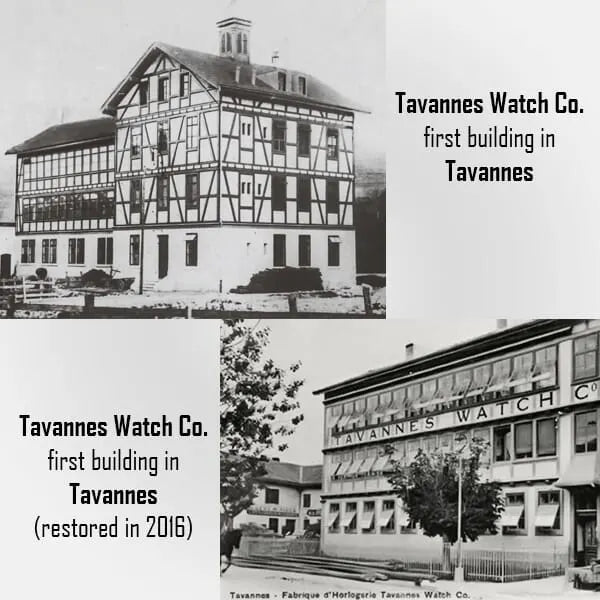
Taban is officially pronounced Tavannu, but in Japan it is known as Taban, so I will continue to use Taban throughout this video.
Watchmaker Henri Frédéric Sandoz founded the watch company that bears his name, Henri Sandoz & Co., in Le Locle in 1870.
He then founded a new company in 1891 in the small town of Taban, near Bern, Switzerland.
The company's name was a direct reference to the region it was in - the company was named Tavannes Watch Co. SA and produced watches, watchmaking machinery and other specialized machinery.
The company Tavan lasted until 1966, when it went bankrupt, but was revived in 2008 through a joint venture partnership of people with an interest in the Tavan brand and history.
(One of the owners is Florin Niculescu, who came to the workshop to see Taban's Submarine watch and interviewed him about the Submarine.)
It seems like the shop has fallen into the common phenomenon of the shape of the watch changing drastically when the owner changes, but since the owners who have taken over are people who are truly interested in Taban, I believe they will be able to restore the good Taban in the future.
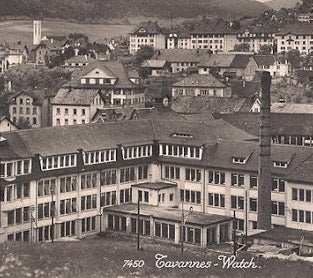
Sales contract with Shuob Brothers
Now let me explain about the Shuob brothers, who were key figures in the creation of Cima.
Choub Frères (Choube Brothers) was founded in 1862 in La Chaux-de-Fonds by Joseph Choub and Theodore Choub as a watch assembly company.
Chevre Frères sourced ébauches (unfinished movements), cases, dials and hands and assembled watches.
It was a typical Swiss assembly company.
Over the years, the company has trademarked numerous brand names and expanded its sales network to sell its watches in overseas markets.
In 1874, the company also acquired sales representative rights in the United States.
In this way, Chevre Frères had the power to sell watches.
Knowing this, Taban immediately entered into a distribution agreement with Shuob Freres (Shuob Brothers).
This does not mean that Taban and Cheobfrère have merged.
The two companies chose to remain independent and separate, giving them greater freedom.
The Taban watch company was able to sell the machinery used to make the watches to other companies, allowing Schaube Frères to continue selling watches under other brand names in addition to Taban.
They decided not to go as far as merging because there was a risk that each company would lose its different cash points.
The Birth of CYMA
The two companies thus signed a sales contract, and the Taban watches sold through the Chevre Frères network were to be sold under the brand name "Cima."
The name Cima has the same Latin origin as French, and means "peak" or "crown" in Latin.
Many Taban watches were sold under the CYMA brand, which increased rapidly between 1900 and the 1950s.
Cima (Taban) was not an "assembly company" that simply purchased movements from other companies and attached dials and cases with its own company name on them, but rather a company that manufactured the movements themselves.
Thus, up until the 1950s, Cima (Taban) was one of the few Swiss manufacturers capable of making watches from scratch, producing most of its movements in-house.
Today's representative brands include Breitling and Heuer, but in reality, they were not able to make their own movements, so they were essentially just assembly companies.
At this time, Taban was the fourth largest watch manufacturer in the world, with records showing sales of over 30 million watches.
At that time, they employed over 3,000 skilled watchmakers and produced approximately 4,000 watches per day.
It is the fourth largest company in the world, which shows just how huge a company it was, and it's no wonder they were chosen by the Dirty Dozen.
However , in 1966, Cima (Tavan) ceased all production and sold the rights to use the brand name to Kronos Holdings.
Submarine watch for submarine commanders, 1917

Tavanne Anzeige 1917
© Tavannes
During World War I, Tavan was commissioned by the commanders of two British submarines to manufacture watches for their divers.
The request was to create a watch that met the following criteria:
(1) Waterproof: The deck is constantly exposed to water, even when the submarine is floating on the surface.
(2) Non-magnetic: Submarines run on electricity underwater, so watches that use magnetic components could be affected in the cramped space of a submarine.
(3) In submarines, a normal balance wheel would not function properly because its expansion rate changes with temperature. Therefore, the balance wheel must be made of a material that expands or contracts as little as possible with temperature changes. This condition can be met by using an alloy of iron and nickel, which expands or contracts little and is not easily affected by temperature changes.
(4) The dial is always easy to read: Regular yellow luminous paint letters, when combined with a white dial, are difficult to read in moonlight, dim light, or weak electrical light. By making the dial black, it becomes easier to read the time accurately in any light.
Meeting all these requirements, Taban produced its first "waterproof wristwatch" in 1917.
The Dirty Dozen dates back to the 1940s, so they must have had connections with the military well before that and had some knowledge of the functions necessary for military watches.
Now let's take a closer look at the hairspring we mentioned earlier.
Paul Pellet's hairspring
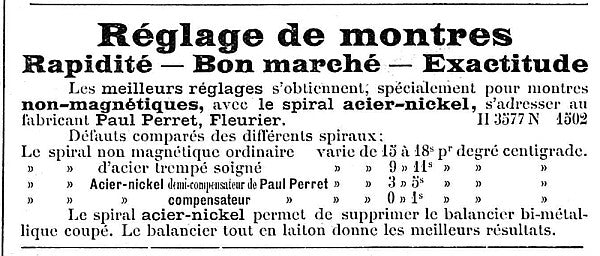
(1901 advertisement for Paul Pellet's nickel-steel alloy hairspring)
When used on a submarine, there was a problem in that the balance spring would expand as the temperature rose, causing the time to become out of sync.
Among them was a Swiss inventor named Paul Perret.
On May 6, 1897, Perret applied for a patent in Switzerland for an escapement equipped with a hairspring whose strength increases with increasing temperature, sufficiently to compensate for the increase in moment of inertia that occurs with a normal (uncompensated) hairspring as the temperature rises, making it difficult to rotate.
The patent was granted in Switzerland on January 15, 1898 as CH 14270, in the UK on February 5, 1898 as GB 25,142, and in the USA on March 12, 1901 as US 669,763.
Perret later started his own company to manufacture hairsprings using this technology.
The advertisement shown above was placed by the Federation of the Swiss Watch Industry (La Fédération horlogère suisse) in 1901.
Under the title, "Timing of watches," it says, "This watch is equipped with a non-magnetic nickel-steel alloy hairspring, allowing for precise timing. For inquiries, please contact Fleurier, the manufacturer of Paul Pellet."
With a normal hairspring, the daily deviation in time due to temperature rise is said to vary from 15 to 18 seconds per degree Celsius, but with Paul Pellet's non-magnetic hairspring made from nickel steel, the deviation is said to be 0 to 1 second per degree Celsius.
A note at the bottom of the ad states that the use of a nickel steel balance spring eliminates the need for a bimetallic balance wheel and allows for an all-brass balance wheel for optimal performance.
Although he died in 1903 at the age of just 49, Perrett would likely have become much more famous if he had continued his research longer.
Throughout his career, Perret continued to work on compensating for variations in the balance wheel and hairspring.
In a research paper on the correction of balance wheels and hairsprings published after Perret's death in 1905, Taban was also listed as one of the companies with which Perret had worked.
Considering this, it is probably no coincidence that Taban was the manufacturer of submarine watches.
Submarine Wristwatch
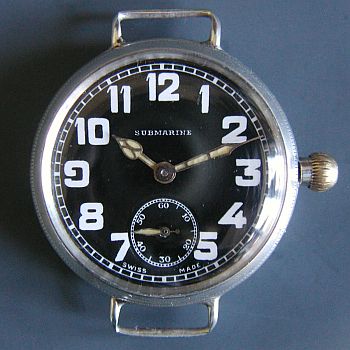
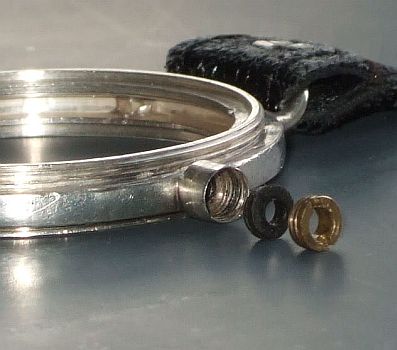

So let's take a look at how the clock actually looked.
Submarine watches were made waterproof by using a screw-down case back and a screw-down bezel.
Both the back and bezel fit snugly against a compressible gasket to improve waterproofing, and also have a water-resistant compression seal to prevent water from entering the case through the hole through which the crown stem passes.
An O-ring is placed in the hole through which the shaft passes and then screwed into the round brass nut attached to the end of the shaft, compressing the O-ring and creating a tight seal.
In this photo, you can also see that there are grooves in the center of the case where the bezel and back cover are screwed in.
A gasket is fitted into a recess dug further inward from the groove for screwing in the back cover to provide a seal.

(NAWCC Watch & Clock article on submarine watches published in 2014)
My thoughts on waterproof watches
Many people consider the Rolex Oyster to be the first waterproof watch, but the case of Taban that I just explained is said to have been around for more than 10 years, making it at least the first or second fastest.
(There is a theory that the best waterproof case is the one made by FB's "Francois Vogel").
If you don't know about Vogel, check out this video:
Submarine watches were also far more practical than the Rolex Oyster.
Since a submarine watch does not require unscrewing the crown to wind the watch or set the time, the threads on the crown axis do not wear out.
Wear and tear on the screw threads was a major issue in the early Oysters, before the introduction of automatic winding.
Also, unlike the Oyster, the Submarine watch remains waterproof while you wind it or set the time.
The waterproof function will not fail if the crown is not tightened after winding the watch, so there is no risk of the watch being damaged if the crown is not tightened, as is the case with a Rolex Oyster.
So, I think the answer to the question of why submarine watches are not better known is that they were created at the request of two submarine commanders during World War I.
Belt watch 1928

Tavanne Belt Watch 1928
© Tavannes
Taban was an early producer of wristwatch movements, introducing small calibers in the 1910s just for this purpose.
They supplied many major manufacturers, including Jaeger-LeCoultre, Dunhill, Hermes and Cartier.
Taban's movement manufacturer is called Lisica SA , and many of their watches use this movement.
One of Tavern's innovations was the belt buckle watch of King Edward VIII of England.
This led to the creation of other "captive" watches for belts and desks, and may have inspired the iconic Jaeger-LeCoultre Reverso, which used a Taban movement.
Hermes and Cartier sold belt buckle watches under the name "La Captive."
Driver's Watch 1930

Tavanne Driver's Watch 1930
© Tavannes
Arguably the two greatest inventions of the 20th century are the luxury mechanical wristwatch and the automobile.
In the early 1930s, various manufacturers made clocks for automobiles.
At the same time, Taban created the Driver's Watch.
This watch is designed to be worn on the side of your wrist to tell you the time while driving.
Production ceased in 1966
but, By 1966 , production had ceased. Swiss watch manufacturer ASUAG announced that same year that It adopted both the Cyma and Tavannes brands under the Chronos Holding company .
Tavannes since 2008

Tavanne Submarine Commander
© Tavannes

Submarine Commander Back
© Tavannes
The Tavannes brand was revived in 2008 , with production once again relocated to the town of Tavannes.
The company aims to bring back its original values as a family business: quality, innovation and originality.
The company's lineup includes historic models with vintage styles.



